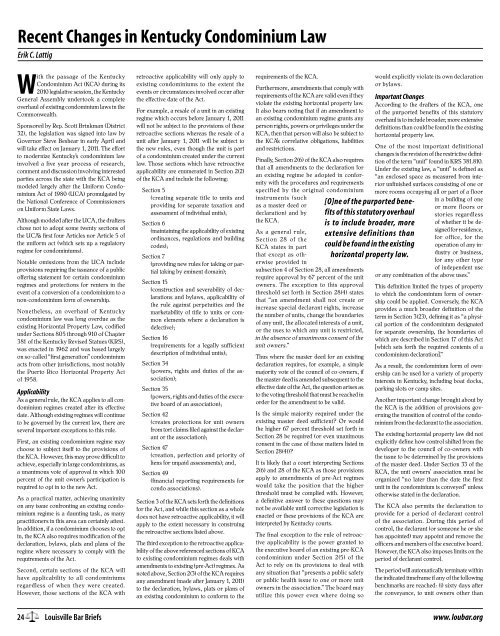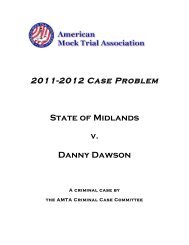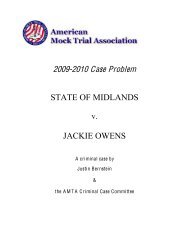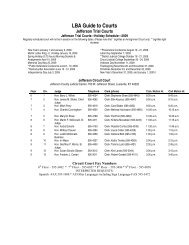Corporate Affiliate Conflicts of Interest - Louisville Bar Association
Corporate Affiliate Conflicts of Interest - Louisville Bar Association
Corporate Affiliate Conflicts of Interest - Louisville Bar Association
Create successful ePaper yourself
Turn your PDF publications into a flip-book with our unique Google optimized e-Paper software.
Recent Changes in Kentucky Condominium Law<br />
Erik C. Lattig<br />
With the passage <strong>of</strong> the Kentucky<br />
Condominium Act (KCA) during its<br />
2010 legislative session, the Kentucky<br />
General Assembly undertook a complete<br />
overhaul <strong>of</strong> existing condominium laws in the<br />
Commonwealth.<br />
Sponsored by Rep. Scott Brinkman (District<br />
32), the legislation was signed into law by<br />
Governor Steve Beshear in early April and<br />
will take effect on January 1, 2011. The effort<br />
to modernize Kentucky’s condominium law<br />
involved a five year process <strong>of</strong> research,<br />
comment and discussion involving interested<br />
parties across the state with the KCA being<br />
modeled largely after the Uniform Condominium<br />
Act <strong>of</strong> 1980 (UCA) promulgated by<br />
the National Conference <strong>of</strong> Commissioners<br />
on Uniform State Laws.<br />
Although modeled after the UCA, the drafters<br />
chose not to adopt some twenty sections <strong>of</strong><br />
the UCA’s first four Articles nor Article 5 <strong>of</strong><br />
the uniform act (which sets up a regulatory<br />
regime for condominiums).<br />
Notable omissions from the UCA include<br />
provisions requiring the issuance <strong>of</strong> a public<br />
<strong>of</strong>fering statement for certain condominium<br />
regimes and protections for renters in the<br />
event <strong>of</strong> a conversion <strong>of</strong> a condominium to a<br />
non-condominium form <strong>of</strong> ownership.<br />
Nonetheless, an overhaul <strong>of</strong> Kentucky<br />
condominium law was long overdue as the<br />
existing Horizontal Property Law, codified<br />
under Sections 805 through 910 <strong>of</strong> Chapter<br />
381 <strong>of</strong> the Kentucky Revised Statues (KRS),<br />
was enacted in 1962 and was based largely<br />
on so-called “first generation” condominium<br />
acts from other jurisdictions, most notably<br />
the Puerto Rico Horizontal Property Act<br />
<strong>of</strong> 1958.<br />
Applicability<br />
As a general rule, the KCA applies to all condominium<br />
regimes created after its effective<br />
date. Although existing regimes will continue<br />
to be governed by the current law, there are<br />
several important exceptions to this rule.<br />
First, an existing condominium regime may<br />
choose to subject itself to the provisions <strong>of</strong><br />
the KCA. However, this may prove difficult to<br />
achieve, especially in large condominiums, as<br />
a unanimous vote <strong>of</strong> approval in which 100<br />
percent <strong>of</strong> the unit owner’s participation is<br />
required to opt in to the new Act.<br />
As a practical matter, achieving unanimity<br />
on any issue confronting an existing condominium<br />
regime is a daunting task, as many<br />
practitioners in this area can certainly attest.<br />
In addition, if a condominium chooses to opt<br />
in, the KCA also requires modification <strong>of</strong> the<br />
declaration, bylaws, plats and plans <strong>of</strong> the<br />
regime where necessary to comply with the<br />
requirements <strong>of</strong> the Act.<br />
Second, certain sections <strong>of</strong> the KCA will<br />
have applicability to all condominiums<br />
regardless <strong>of</strong> when they were created.<br />
However, those sections <strong>of</strong> the KCA with<br />
retroactive applicability will only apply to<br />
existing condominiums to the extent the<br />
events or circumstances involved occur after<br />
the effective date <strong>of</strong> the Act.<br />
For example, a resale <strong>of</strong> a unit in an existing<br />
regime which occurs before January 1, 2011<br />
will not be subject to the provisions <strong>of</strong> these<br />
retroactive sections whereas the resale <strong>of</strong> a<br />
unit after January 1, 2011 will be subject to<br />
the new rules, even though the unit is part<br />
<strong>of</strong> a condominium created under the current<br />
law. Those sections which have retroactive<br />
applicability are enumerated in Section 2(2)<br />
<strong>of</strong> the KCA and include the following:<br />
Section 5<br />
(creating separate title to units and<br />
providing for separate taxation and<br />
assessment <strong>of</strong> individual units);<br />
Section 6<br />
(maintaining the applicability <strong>of</strong> existing<br />
ordinances, regulations and building<br />
codes);<br />
Section 7<br />
(providing new rules for taking or partial<br />
taking by eminent domain);<br />
Section 15<br />
(construction and severability <strong>of</strong> declarations<br />
and bylaws, applicability <strong>of</strong><br />
the rule against perpetuities and the<br />
marketability <strong>of</strong> title to units or common<br />
elements where a declaration is<br />
defective);<br />
Section 16<br />
(requirements for a legally sufficient<br />
description <strong>of</strong> individual units);<br />
Section 34<br />
(powers, rights and duties <strong>of</strong> the association);<br />
Section 35<br />
(powers, rights and duties <strong>of</strong> the executive<br />
board <strong>of</strong> an association);<br />
Section 42<br />
(creates protections for unit owners<br />
from tort claims filed against the declarant<br />
or the association);<br />
Section 47<br />
(creation, perfection and priority <strong>of</strong><br />
liens for unpaid assessments); and,<br />
Section 49<br />
(financial reporting requirements for<br />
condo associations).<br />
Section 3 <strong>of</strong> the KCA sets forth the definitions<br />
for the Act, and while this section as a whole<br />
does not have retroactive applicability, it will<br />
apply to the extent necessary in construing<br />
the retroactive sections listed above.<br />
The third exception to the retroactive applicability<br />
<strong>of</strong> the above referenced sections <strong>of</strong> KCA<br />
to existing condominium regimes deals with<br />
amendments to existing (pre-Act) regimes. As<br />
noted above, Section 2(3) <strong>of</strong> the KCA requires<br />
any amendment (made after January 1, 2011)<br />
to the declaration, bylaws, plats or plans <strong>of</strong><br />
an existing condominium to conform to the<br />
requirements <strong>of</strong> the KCA.<br />
Furthermore, amendments that comply with<br />
requirements <strong>of</strong> the KCA are valid even if they<br />
violate the existing horizontal property law.<br />
It also bears noting that if an amendment to<br />
an existing condominium regime grants any<br />
person rights, powers or privileges under the<br />
KCA, then that person will also be subject to<br />
the KCA’s correlative obligations, liabilities<br />
and restrictions.<br />
Finally, Section 2(6) <strong>of</strong> the KCA also requires<br />
that all amendments to the declaration for<br />
an existing regime be adopted in conformity<br />
with the procedures and requirements<br />
specified by the original condominium<br />
instruments (such<br />
as a master deed or<br />
declaration) and by<br />
the KCA.<br />
As a general rule,<br />
Section 28 <strong>of</strong> the<br />
KCA states in part<br />
that except as otherwise<br />
provided in<br />
subsection 4 <strong>of</strong> Section 28, all amendments<br />
require approval by 67 percent <strong>of</strong> the unit<br />
owners. The exception to this approval<br />
threshold set forth in Section 28(4) states<br />
that “an amendment shall not create or<br />
increase special declarant rights, increase<br />
the number <strong>of</strong> units, change the boundaries<br />
<strong>of</strong> any unit, the allocated interests <strong>of</strong> a unit,<br />
or the uses to which any unit is restricted,<br />
in the absence <strong>of</strong> unanimous consent <strong>of</strong> the<br />
unit owners.”<br />
Thus where the master deed for an existing<br />
declaration requires, for example, a simple<br />
majority vote <strong>of</strong> the council <strong>of</strong> co-owners, if<br />
the master deed is amended subsequent to the<br />
effective date <strong>of</strong> the Act, the question arises as<br />
to the voting threshold that must be reached in<br />
order for the amendment to be valid.<br />
Is the simple majority required under the<br />
existing master deed sufficient? Or would<br />
the higher 67 percent threshold set forth in<br />
Section 28 be required (or even unanimous<br />
consent in the case <strong>of</strong> those matters listed in<br />
Section 28(4))?<br />
It is likely that a court interpreting Sections<br />
2(6) and 28 <strong>of</strong> the KCA as those provisions<br />
apply to amendments <strong>of</strong> pre-Act regimes<br />
would take the position that the higher<br />
threshold must be complied with. However,<br />
a definitive answer to these questions may<br />
not be available until corrective legislation is<br />
enacted or these provisions <strong>of</strong> the KCA are<br />
interpreted by Kentucky courts.<br />
The final exception to the rule <strong>of</strong> retroactive<br />
applicability is the power granted to<br />
the executive board <strong>of</strong> an existing pre-KCA<br />
condominium under Section 2(5) <strong>of</strong> the<br />
Act to rely on its provisions to deal with<br />
any situation that “presents a public safety<br />
or public health issue to one or more unit<br />
owners in the association.” The board may<br />
utilize this power even where doing so<br />
[O]ne <strong>of</strong> the purported benefits<br />
<strong>of</strong> this statutory overhaul<br />
is to include broader, more<br />
ex tensive definitions than<br />
could be found in the existing<br />
horizontal property law.<br />
would explicitly violate its own declaration<br />
or bylaws.<br />
Important Changes<br />
According to the drafters <strong>of</strong> the KCA, one<br />
<strong>of</strong> the purported benefits <strong>of</strong> this statutory<br />
overhaul is to include broader, more extensive<br />
definitions than could be found in the existing<br />
horizontal property law.<br />
One <strong>of</strong> the most important definitional<br />
changes is the revision <strong>of</strong> the restrictive definition<br />
<strong>of</strong> the term “unit” found in KRS 381.810.<br />
Under the existing law, a “unit” is defined as<br />
“an enclosed space as measured from interior<br />
unfinished surfaces consisting <strong>of</strong> one or<br />
more rooms occupying all or part <strong>of</strong> a floor<br />
in a building <strong>of</strong> one<br />
or more floors or<br />
stories regardless<br />
<strong>of</strong> whether it be designed<br />
for residence,<br />
for <strong>of</strong>fice, for the<br />
operation <strong>of</strong> any industry<br />
or business,<br />
for any other type<br />
<strong>of</strong> independent use<br />
or any combination <strong>of</strong> the above uses.”<br />
This definition limited the types <strong>of</strong> property<br />
to which the condominium form <strong>of</strong> ownership<br />
could be applied. Conversely, the KCA<br />
provides a much broader definition <strong>of</strong> the<br />
term in Section 3(23), defining it as “a physical<br />
portion <strong>of</strong> the condominium designated<br />
for separate ownership, the boundaries <strong>of</strong><br />
which are described in Section 17 <strong>of</strong> this Act<br />
[which sets forth the required contents <strong>of</strong> a<br />
condominium declaration].”<br />
As a result, the condominium form <strong>of</strong> ownership<br />
can be used for a variety <strong>of</strong> property<br />
interests in Kentucky, including boat docks,<br />
parking slots or camp sites.<br />
Another important change brought about by<br />
the KCA is the addition <strong>of</strong> provisions governing<br />
the transition <strong>of</strong> control <strong>of</strong> the condominium<br />
from the declarant to the association.<br />
The existing horizontal property law did not<br />
explicitly define how control shifted from the<br />
developer to the council <strong>of</strong> co-owners with<br />
the issue to be determined by the provisions<br />
<strong>of</strong> the master deed. Under Section 33 <strong>of</strong> the<br />
KCA, the unit owners’ association must be<br />
organized “no later than the date the first<br />
unit in the condominium is conveyed” unless<br />
otherwise stated in the declaration.<br />
The KCA also permits the declaration to<br />
provide for a period <strong>of</strong> declarant control<br />
<strong>of</strong> the association. During this period <strong>of</strong><br />
control, the declarant (or someone he or she<br />
has appointed) may appoint and remove the<br />
<strong>of</strong>ficers and members <strong>of</strong> the executive board.<br />
However, the KCA also imposes limits on the<br />
period <strong>of</strong> declarant control.<br />
The period will automatically terminate within<br />
the indicated timeframe if any <strong>of</strong> the following<br />
benchmarks are reached: (i) sixty days after<br />
the conveyance, to unit owners other than<br />
24 <strong>Louisville</strong> <strong>Bar</strong> Briefs<br />
www. loubar.org







